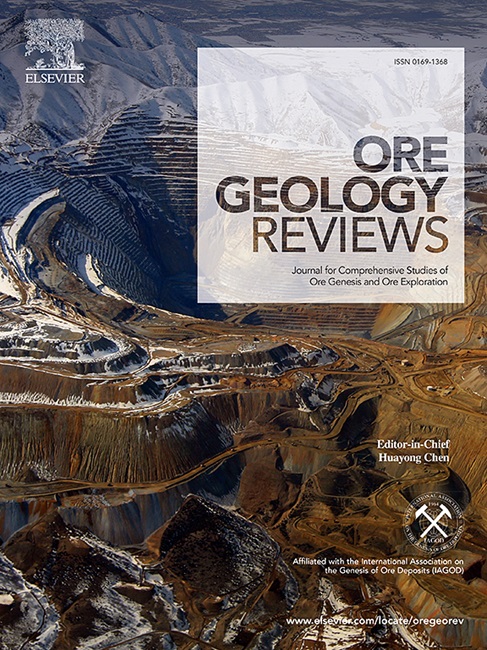Thermal-tectonic history of the İspir-Ulutaş porphyry Cu-Mo deposit, Eastern Pontides: Implications for regional tectonics and exploration of porphyry systems
IF 3.2
2区 地球科学
Q1 GEOLOGY
引用次数: 0
Abstract
This study employs multiple low-temperature thermochronology techniques—Apatite Fission Track (AFT), Apatite (U-Th)/He (AHe), and Zircon (U-Th)/He (ZHe)—to reveal the cooling, exhumation, and preservation history of the İspir-Ulutaş porphyry Cu-Mo deposit, the oldest known porphyry deposit in the Eastern Pontides (∼131 Ma), and to investigate the relative scarcity of the porphyry systems in the Eastern Pontides.
The inverse thermal history model reveals a complex multi-stage cooling/exhumation history of the İspir-Ulutaş deposit. The ZHe data and thermal model indicate that the deposit was emplaced at a paleodepth of over 5 km at ∼ 131 Ma. The deposit experienced two major exhumation stages. The first, occurring during the Middle Eocene (∼43–38 Ma), was triggered by anomalous regional compressional forces likely due to the subduction of a mid-ocean ridge along the Bitlis-Zagros suture zone. During this phase, the porphyry system was exhumed to near-surface levels, but only its uppermost parts were eroded. Shortly after, post-collisional volcanic and sedimentary sequences buried the deposit, temporarily protecting it from further erosion. The second major exhumation phase, recorded by AHe data, began around 18 Ma and continues to the present, resulting in approximately 2.5 km of erosion. This phase aligns with the timing of the Arabia-Eurasia collision, which caused gradual uplift and exhumation across the region.
In summary, the deep emplacement of the İspir-Ulutaş deposit (>5 km), combined with the post-mineralization burial by Eocene sequences, extended slow exhumation, and drier/continental climatic conditions, played key roles in the preservation of the porphyry system. Lastly, the study proposes that areas in the southern Eastern Pontides, particularly those covered by Eocene sequences, may offer promising exploration targets for new porphyry deposits.

东庞德岛İspir-Ulutaş斑岩型铜钼矿床的热构造史:对区域构造和斑岩系统勘探的启示
本研究采用磷灰石裂变径迹(AFT)、磷灰石(U-Th)/He (AHe)和锆石(U-Th)/He (ZHe)等低温热年代学技术,揭示了东塘已知最古老的斑岩矿床(~ 131 Ma) İspir-Ulutaş斑岩铜钼矿床的冷却、挖掘和保存历史,并探讨了东塘斑岩体系的相对稀缺性。逆热史模型揭示了İspir-Ulutaş矿床复杂的多阶段冷却/掘出历史。喆资料和热模型表明,该矿床位于约131 Ma的古深度5 km以上。该矿床经历了两个主要的挖掘阶段。第一次发生在中始新世(~ 43-38 Ma),可能是由沿Bitlis-Zagros缝合带的洋中脊俯冲引起的异常区域挤压力引发的。在这一阶段,斑岩系统被挖掘到近地表,但只有最上面的部分被侵蚀。不久之后,碰撞后的火山和沉积序列掩埋了沉积物,暂时保护了它免受进一步的侵蚀。AHe数据记录的第二次主要挖掘阶段大约从18ma开始,一直持续到现在,造成了大约2.5公里的侵蚀。这个阶段与阿拉伯-欧亚大陆碰撞的时间一致,这导致了整个地区的逐渐隆起和挖掘。综上所述,İspir-Ulutaş矿床的深侵位(>5 km)、始新世层序的成矿后埋藏、延长的缓慢发掘和干燥/大陆性气候条件对斑岩体系的保存起了关键作用。最后,研究提出东庞德兹南部地区,特别是始新世层序覆盖的地区,可能为新的斑岩矿床提供有希望的勘探目标。
本文章由计算机程序翻译,如有差异,请以英文原文为准。
求助全文
约1分钟内获得全文
求助全文
来源期刊

Ore Geology Reviews
地学-地质学
CiteScore
6.50
自引率
27.30%
发文量
546
审稿时长
22.9 weeks
期刊介绍:
Ore Geology Reviews aims to familiarize all earth scientists with recent advances in a number of interconnected disciplines related to the study of, and search for, ore deposits. The reviews range from brief to longer contributions, but the journal preferentially publishes manuscripts that fill the niche between the commonly shorter journal articles and the comprehensive book coverages, and thus has a special appeal to many authors and readers.
 求助内容:
求助内容: 应助结果提醒方式:
应助结果提醒方式:


